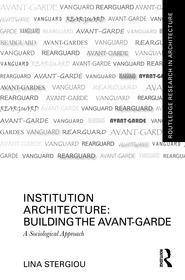
Institution Architecture: Building the Avant-Garde
A Sociological Approach
Sorozatcím: Routledge Research in Architecture;
-
10% KEDVEZMÉNY?
- A kedvezmény csak az 'Értesítés a kedvenc témákról' hírlevelünk címzettjeinek rendeléseire érvényes.
- Kiadói listaár GBP 145.00
-
69 273 Ft (65 975 Ft + 5% áfa)
Az ár azért becsült, mert a rendelés pillanatában nem lehet pontosan tudni, hogy a beérkezéskor milyen lesz a forint árfolyama az adott termék eredeti devizájához képest. Ha a forint romlana, kissé többet, ha javulna, kissé kevesebbet kell majd fizetnie.
- Kedvezmény(ek) 10% (cc. 6 927 Ft off)
- Kedvezményes ár 62 346 Ft (59 378 Ft + 5% áfa)
Iratkozzon fel most és részesüljön kedvezőbb árainkból!
Feliratkozom
69 273 Ft

Beszerezhetőség
Még nem jelent meg, de rendelhető. A megjelenéstől számított néhány héten belül megérkezik.
Why don't you give exact delivery time?
A beszerzés időigényét az eddigi tapasztalatokra alapozva adjuk meg. Azért becsült, mert a terméket külföldről hozzuk be, így a kiadó kiszolgálásának pillanatnyi gyorsaságától is függ. A megadottnál gyorsabb és lassabb szállítás is elképzelhető, de mindent megteszünk, hogy Ön a lehető leghamarabb jusson hozzá a termékhez.
A termék adatai:
- Kiadás sorszáma 1
- Kiadó Routledge
- Megjelenés dátuma 2025. december 8.
- ISBN 9781032191270
- Kötéstípus Keménykötés
- Terjedelem330 oldal
- Méret 234x156 mm
- Nyelv angol
- Illusztrációk 4 Illustrations, black & white; 4 Line drawings, black & white; 8 Tables, black & white 700
Kategóriák
Rövid leírás:
Institution Architecture: Building the Avant-garde takes a terminological, sociological and semiological approach that develops by tracing the ‘avant-garde’ in a century span of literatures for a textual analysis, unpacking the text, and in a process analysis, interpreting it.
Több
Hosszú leírás:
Institution Architecture: Building the Avant-garde takes a terminological, sociological and semiological approach that develops by tracing the ‘avant-garde’ in a century span of literatures for a textual analysis, unpacking the text, and in a process analysis, interpreting it.
The sources consist of 825 well-known, globally influential European, including Russian, architectural literatures of the extended 1920s, and of Anglo-Saxon literatures of the extended 1960s to the 2010s. The book traces the denotations that the term ‘avant-garde’ acquires in them and shows the different notions under the ‘avant-garde’ signifier, directing attention to the term’s early twentieth-century roots and modes, its 1960s rising usage, modes and function, and its post-1960s to 2010s developments. It sheds light on the sociological topography of the avant-garde, and through the writings, on the ways in which the term and avant-gardism connect, the actors, agencies and mediators therein, on the terms’ techniques and modes, indicating the reasons for its heretofore limited systematic inquiry. This book aims at unravelling a century-old ‘avant-garde’ mystic function for unlocking horizontal, plural, and transparent conversations about intra- and inter-disciplinary futures including architecture. This close terminological interrogation could open up inter-terminological, horizontal, transnational, intersubjective discourses of values and liberatory dynamics in cross-disciplinary dialogues. The book will therefore be relevant to scholars and researchers interested in the avant-garde in architecture.
TöbbTartalomjegyzék:
Acknowledgements
Abbreviations
Introduction: ‘Avant-Garde’ Coloniality of Value
Chapter One: Institution Arts, 1960s and after: ‘Avant-Garde’ Origins Mediation, Agency
Chapter Two: Institution Architecture, 1920s: Avant-gardism - ‘Avant-Garde’ -Vanguard
Chapter Three: Institution Architecture, 1960s: ‘Avant-Garde’ Roots and Function
Chapter Four: 1960s-70s ‘Avant-Garde’ Architecture
Chapter Five: 1960s-80s Avant-gardism
Chapter Six: Strategy ‘Avant-Garde’ Avant-gardism. Two Cases 1960s-1980s
Chapter Seven: ‘Russian Avant-Garde’
Chapter Eight: Avant-Garde Semiotic Domain: Subcategories. Unprofessionalisation
Appendix
Primary and Main Sources
Bibliography and Reference List
Index




